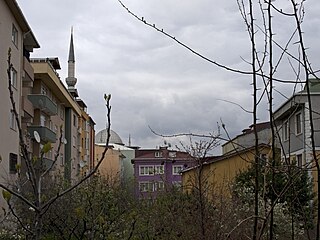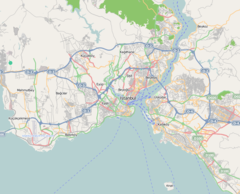
Hordeum is a genus of annual and perennial plants in the grass family. They are native throughout the temperate regions of Africa, Eurasia, and the Americas.
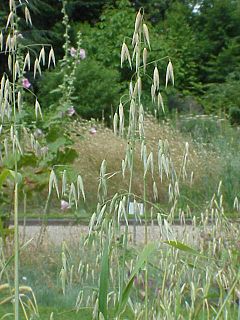
Avena is a genus of Eurasian and African plants in the grass family. Collectively known as the oats, they include some species which have been cultivated for thousands of years as a food source for humans and livestock. They are widespread throughout Europe, Asia and northwest Africa. Several species have become naturalized in many parts of the world, and are regarded as invasive weeds where they compete with crop production. All oats have edible seeds, though they are small and hard to harvest in most species.
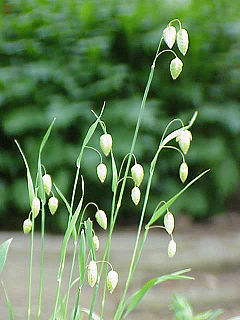
Briza is a genus of annual and perennial plants in the grass family, native to northern temperate regions of Eurasia, North Africa, and certain islands in the Atlantic.

Poa is a genus of about 500 species of grasses, native to the temperate regions of both hemispheres. Common names include meadow-grass, bluegrass, tussock, and speargrass. Poa (πόα) is Greek for "fodder". Poa are members of the Pooideae subfamily of the Poaceae family.

Avena fatua is a species of grass in the oat genus. It is known as the common wild oat. This oat is native to Eurasia but it has been introduced to most of the other temperate regions of the world. It is naturalized in some areas and considered a noxious weed in others.
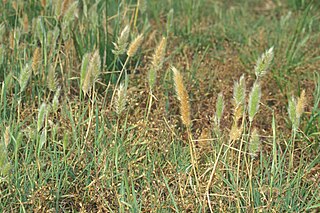
Polypogon is a nearly cosmopolitan genus of plants in the grass family, commonly known beard grass or rabbitsfoot grass.
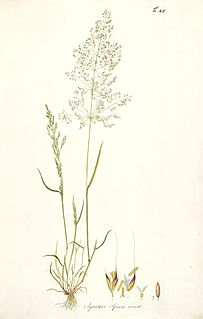
Apera is a small genus of annual grasses, known commonly as silkybent grass or windgrass. They are native to Europe, North Africa and parts of Asia but have been introduced and naturalized in much of North and South America.
- Apera baytopianaDogan - Muğla Province in southwestern Turkey
- Apera intermediaHack. - Turkey, Aegean Islands, Iraq, Iran, Caucasus; naturalized in Primorye
- Apera interrupta(L.) P.Beauv. - dense silkybent, interrupted windgrass - Eurasia and North Africa from Portugal to Sweden to Algeria to Kazakhstan; naturalized in Argentina, Chile, United States, Canada
- Apera spica-venti(L.) P. Beauv. - loose silkybent, common windgrass - Eurasia and North Africa from Canary Islands to Denmark to Yakutia; naturalized in United States, Canada, and Russian Far East
- Apera triaristataDogan - Denizli Province in southwestern Turkey
Atatürk Forest Farm and Zoo is an expansive recreational farming area, which houses a zoo, several small agricultural farms, greenhouses, restaurants, a dairy farm and a brewery in Ankara, Turkey. The farm and the zoo are under the administration of the Ministry of Agriculture and Village Affairs.
Zingeria is a genus of Asian and European plants in the grass family. Their native range covers the Black Sea and eastern Mediterranean regions from Romania to Kazakhstan.
Loliolum is a genus of Asian and North African plants in the grass family. The only known species is Loliolum subulatum, native to Turkey, Caucasus, the Middle East, Iran, Pakistan, Afghanistan, Central Asia, and Morocco.
Avellinia is a genus of Mediterranean plants in the grass family. The only known species is Avellinia festucoides, found throughout much of the Mediterranean Region from Portugal and Morocco to Turkey. It is also reportedly naturalized in Australia.

Scolochloa is a genus of grasses in the family Poaceae / Gramineae, now containing a single species, Scolochloa festucacea. Common rivergrass is a common name for the species. Scolochloa festucacea grows in Europe, temperate Asia, and North America. Its culms are erect and 100–150 centimetres (39–59 in) in height; its leaf blades are 15–30 cm (5.9–11.8 in) long and 5–10 mm (0.20–0.39 in) wide.
Heteranthelium is a genus of Asian plants in the grass family. The only known species is Heteranthelium piliferum, native to Central Asia, Afghanistan, Pakistan, Iran, Middle East, Turkey, and the Caucasus.
Henrardia is a genus of Asian plants in the grass family.
- Henrardia persica(Boiss.) C.E.Hubb. - Kazakhstan, Kyrgyzstan, Turkmenistan, Uzbekistan, Tajikistan, Afghanistan, Iran, Turkey, Pakistan, Syria, Lebanon
- Henrardia pubescensC.E.Hubb. - Syria, Lebanon, Israel, Palestine, Jordan, Iraq, Iran

Mibora, sandgrass, is a genus of European and North African plants in the grass family.
Narduroides is a genus of Mediterranean plants in the grass family. The only known species is Narduroides salzmannii, native to Spain, France, Morocco, Algeria, Libya, Cyprus, and Turkey.
Nephelochloa is a genus of Turkish plants in the grass family. The only known species is Nephelochloa orientalis, found only in Turkey.
Rhizocephalus is a genus of plants in the grass family. The only known species is Rhizocephalus orientalis, native to Afghanistan, Armenia, Georgia, Iran, Iraq, Israel, Jordan, Lebanon, Palestine, Syria, AsiaticTurkey, and Uzbekistan.

Dana Island is a small Mediterranean island of Turkey.

Panayır Island is an Aegean island of Turkey. It was once known as Ziraat Island. It is now also known as Altın Adası. The island is a part of Didim ilçe (district) of Aydın Province at 37°19′36″N27°19′50″E The area of the island is about 0.4 square kilometres (0.15 sq mi). Its distance to main land is 1.4 kilometres (0.87 mi).


